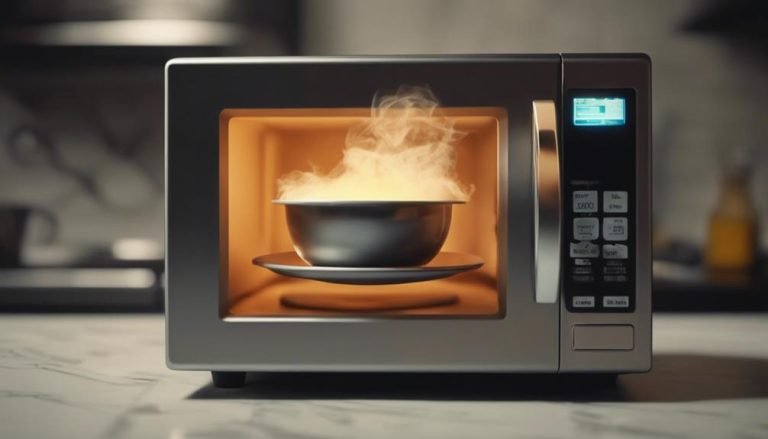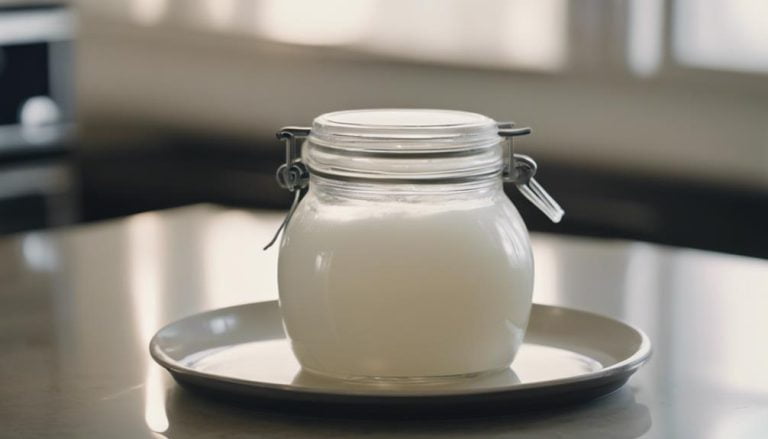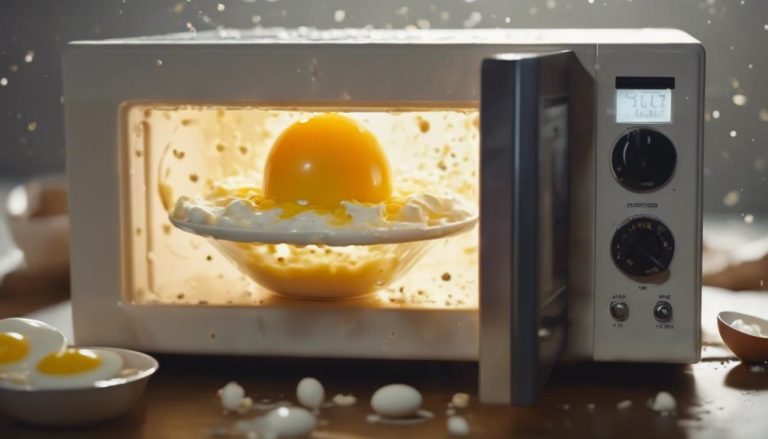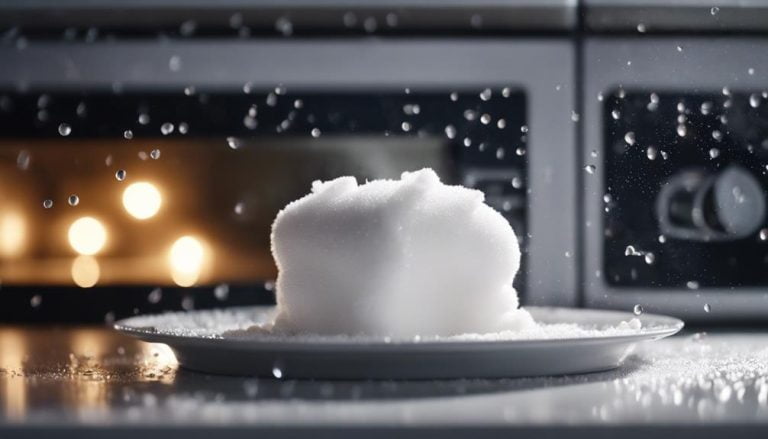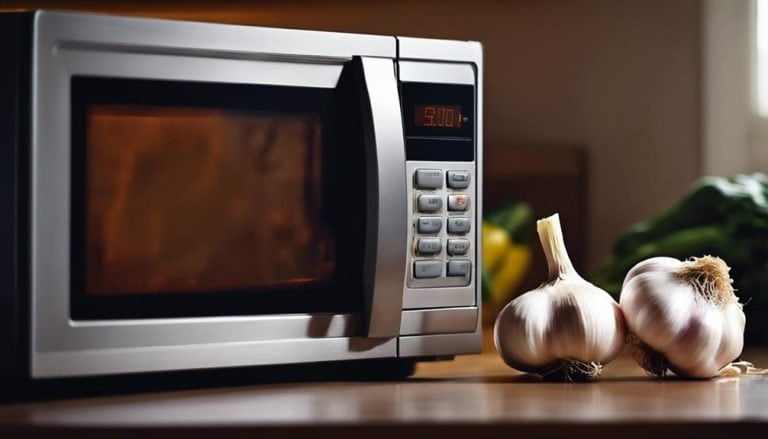Can You Microwave Aluminum Foil
Yes, it is generally safe to microwave aluminum foil. However, there are a few precautions to keep in mind.
Firstly, ensure that the foil is not crumpled or tightly wrapped around the food as this can cause sparks. It is also important to avoid using foil with sharp edges or pieces that are too large, as they can cause the microwave to overheat.
Additionally, be cautious when microwaving acidic or salty foods, as these can cause the foil to break down and release harmful substances.
Overall, as long as you use aluminum foil properly and follow these guidelines, it can be safely used in the microwave.
Key Takeaways
- Avoid using aluminum foil in the microwave without food to prevent fires and sparks.
- Use new, smooth foil covering a maximum of 1/4 of food to ensure safe usage.
- Inhaling fumes from heated foil can lead to health hazards, use caution.
- Opt for eco-friendly alternatives like silicone lids to reduce environmental impact.
Safety Concerns of Microwaving Aluminum Foil
While aluminum foil is a common kitchen item, caution must be exercised when considering its use in microwaves due to safety concerns. The risk lies in the fact that aluminum foil is a metal, which can cause sparking when exposed to the radio waves inside the microwave.
When subjected to high voltage, the thin aluminum foil can act as an antenna, generating an electric charge that can lead to sparks. To mitigate this risk, it is essential to follow specific guidelines, such as using smooth, unwrinkled foil, only covering a quarter of the food, and ensuring the foil is at least one inch away from the walls.
Failure to adhere to these precautions can result in the foil heating up, potentially igniting and causing a fire, as warned by the FDA.
Potential Risks and Dangers Involved
Microwaving aluminum foil poses significant risks due to its potential to spark fires in the microwave, causing damage to the appliance and potentially leading to a fire hazard in the kitchen.
The high heat conductivity of aluminum makes it prone to melting in a microwave, increasing the likelihood of damage and posing a safety threat.
Moreover, the fumes emitted when aluminum foil is heated can have health hazards if inhaled, further emphasizing the dangers associated with using aluminum foil in microwaves.
Foil Sparking Fire Risk
When using aluminum foil in the microwave, the potential risks and dangers of sparking and fire must be carefully considered. Aluminum, being a metal, can cause sparks and fires when exposed to the intense heat and energy inside a microwave.
Here are four reasons why the risk of sparking and fire is high when using aluminum foil in the microwave:
- Metal Composition: Aluminum foil's metal composition can lead to sparks when microwaved.
- Contact with Other Metals: Contact between the foil and other metal components in the microwave can increase the risk of fire.
- Quick Ignition: Sparks and fires can quickly ignite due to the high energy levels in the microwave.
- Appliance Damage: Even short exposure of aluminum foil can result in dangerous situations like fires or damage to the microwave.
Aluminum Melting in Microwave
Aluminum foil's susceptibility to melting in a microwave presents inherent risks and potential dangers that warrant careful consideration. Due to its thinness and metal composition, aluminum foil can easily melt in a microwave, leading to arcing, sparking, and potential fire hazards.
The high reflectivity of foil causes rapid heating, increasing the likelihood of melting. When aluminum foil melts in a microwave, it can damage the appliance, posing safety risks and necessitating thorough cleaning.
To ensure safety, it is crucial never to intentionally melt aluminum foil in a microwave and always adhere to safe usage guidelines to prevent accidents and maintain the integrity of the microwave.
Health Hazards From Fumes
Exposure to fumes emitted from heated aluminum foil poses potential health risks and dangers, particularly impacting respiratory function and neurological well-being over time. When considering the health hazards from fumes when using aluminum foil in a microwave oven, several key points should be noted:
- Inhaling aluminum foil fumes can lead to respiratory issues and lung damage due to the release of toxins.
- Exposure to aluminum foil fumes can cause irritation to the eyes, nose, and throat, impacting respiratory health.
- Heating aluminum foil in a microwave can release harmful aluminum particles into the air when inhaled.
- Prolonged or repeated exposure to aluminum foil fumes may increase the risk of neurological disorders and cognitive impairment.
To safeguard against these risks, it is essential to avoid using aluminum foil in microwave ovens for cooking or heating food.
Benefits of Using Aluminum Foil
Utilizing aluminum foil in microwave cooking offers numerous advantages for enhancing the efficiency and quality of food preparation. Using aluminum foil in the microwave helps shield food, keeping it safe from overcooking while maintaining its moisture levels.
The foil's ability to reflect microwaves onto the food promotes even heating, ensuring consistent cooking throughout. Additionally, aluminum foil can be molded around food items to create a barrier that retains heat, speeding up the cooking process.
This versatile tool also aids in reducing splattering and mess, making cleanup easier after microwaving. When used correctly and in moderation, aluminum foil proves to be a valuable asset for efficiently microwaving certain foods.
How to Safely Use Aluminum Foil
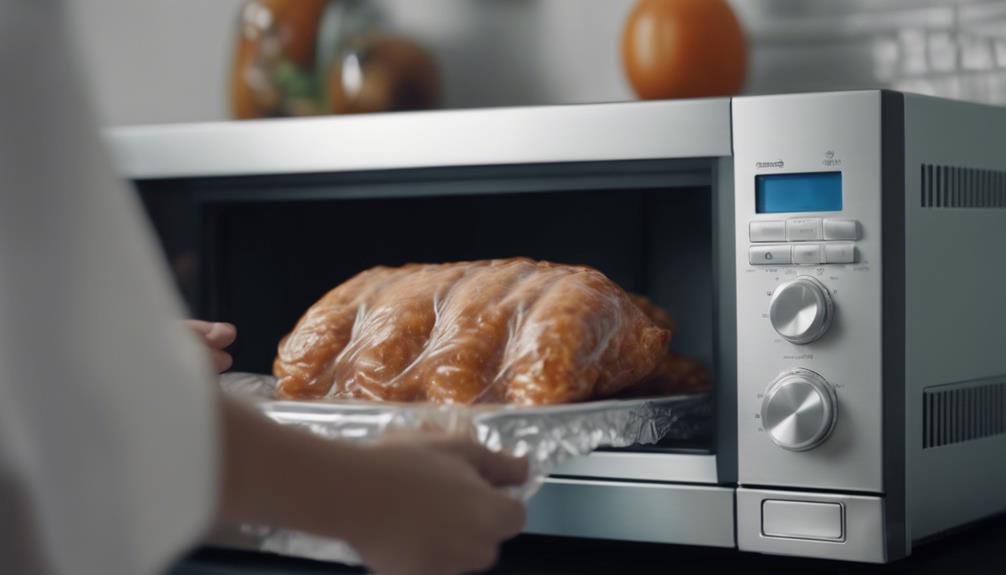
When incorporating aluminum foil in microwave cooking, it is essential to adhere to safety guidelines to prevent potential hazards and ensure optimal results. To safely use aluminum foil in the microwave, follow these tips:
- Use new, smooth foil: Choose a smooth foil to prevent arcing in the microwave and maintain safety.
- Cover a maximum of 1/4 of the food: Limit the amount of food covered by foil to prevent issues and ensure safe usage.
- Shape the foil smoothly: Wrap the foil smoothly around the food and keep at least a one-inch distance from the oven walls for proper heating.
- Avoid using foil with metal shelves or turntables: If your microwave contains metal components, refrain from using aluminum foil to prevent hazards and maintain microwave safety.
Common Misconceptions Debunked
In the realm of microwaving aluminum foil, prevalent misconceptions surrounding its safety and potential hazards need to be addressed. Understanding the truth about using foil in the microwave, dispelling safety concerns, and adopting proper usage tips can help users navigate this kitchen staple effectively and safely.
Foil in Microwave
Despite prevailing misconceptions, the safe use of aluminum foil in the microwave can be effectively achieved with proper adherence to recommended guidelines. When using foil in the microwave, it is important to note that the shiny or dull side does not significantly affect its performance.
To make the most of foil in microwave cooking, consider these tips:
- Partial Covering: Covering food partially with foil can help enhance cooking efficiency.
- Reflectivity: The reflective properties of aluminum foil can help distribute heat evenly when used correctly.
- Guidelines: Following specific guidelines for using foil in microwaves can prevent potential hazards.
- Avoiding Fire Risks: Correct usage of aluminum foil in the microwave can prevent the risk of fires and accidents.
Safety Concerns Addressed
Addressing common misconceptions about the safety concerns related to microwaving aluminum foil requires a clear understanding of the specific conditions that must be met for safe usage. To minimize the risk of sparking or fires, it's essential to make sure the foil is smooth, brand new, and without wrinkles before using it in the microwave.
When covering food with foil, only use small amounts, limiting it to a maximum of 1/4 of the food's surface area while maintaining a distance of at least one inch from the walls of the microwave. Despite taking precautions, there is still a risk of sparking, so if it occurs, promptly remove the foil to prevent any potential hazards.
Proper Usage Tips
When using aluminum foil in the microwave, proper technique is crucial to prevent sparking or fires. To ensure safe usage of aluminum foil in the microwave, follow these tips:
- Use Aluminum Foil Sparingly: Cover only up to 1/4 of the food with foil and keep it at least one inch away from the walls of the microwave.
- Remove the Foil Shielding Promptly: If arcing or sparking occurs during microwaving, stop the microwave immediately and carefully remove the foil to prevent any further danger.
- Smoothly Cover the Food: Use smooth, brand new foil without any wrinkles to minimize the chances of sparking or electrical discharge.
- Consider Alternatives: For a safer option, opt for microwave-safe alternatives like ceramic plates or biodegradable wax paper to cover your food in the microwave.
Tips for Microwaving With Aluminum Foil
For optimal safety and performance when microwaving with aluminum foil, adhere to these essential tips.
Use new, smooth foil to prevent arcing and ensure safe microwave use. Cover only a maximum of 1/4 of the food with foil to avoid sparking. Shape the foil smoothly around the food for even heating.
Maintain a distance of at least one inch from the microwave walls to prevent accidents. If the foil edges stick or spark, immediately remove the foil to prevent damage.
There is no significant difference in which side of the foil faces the food, but ensuring it is smooth and properly placed is crucial for safe microwaving.
Frequently Asked Questions
Can Microwaving Aluminum Foil Cause Damage to the Microwave Itself?
Microwave safety is paramount. When aluminum foil is microwaved, it poses potential hazards such as sparking, fires, and damage to the appliance. Adherence to aluminum foil precautions is crucial to prevent these risks.
Is It Safe to Use Aluminum Foil in a Microwave Oven at All Times?
Safety concerns surrounding the use of aluminum foil in a microwave are paramount. Opting for alternatives like ceramic plates or wax paper is advisable. Embracing best practices, such as avoiding foil in microwaves, ensures a secure cooking environment.
Can Microwaving Aluminum Foil Lead to Chemical Reactions That Are Harmful to Food?
Microwaving aluminum foil can indeed lead to harmful chemical reactions in food. It is crucial to prioritize food safety by avoiding the use of aluminum foil in microwaves. Taking appropriate microwave precautions can prevent foil reactions and ensure food safety.
Are There Any Specific Types of Aluminum Foil That Should Not Be Used in the Microwave?
When considering microwave safety, it's crucial to note that thin or lightweight aluminum foil is more prone to igniting. To avoid risks, opt for heavy-duty foil over thinner varieties. Additionally, explore aluminum foil alternatives to ensure safe microwave usage.
Does the Size or Shape of the Aluminum Foil Matter When It Comes to Microwaving?
In microwaving, the size and shape of aluminum foil are crucial factors influencing heating efficiency. Foil thickness, shape variations, and proper positioning impact cooking outcomes. Following guidelines on foil usage ensures safe and effective microwave cooking practices.
Conclusion
In the realm of microwave cooking, the use of aluminum foil is like walking a tightrope.
While it offers benefits, the risks of sparking and fire hazards loom ominously.
By following safety guidelines and being vigilant, one can navigate this perilous path with caution.
Remember, like a skilled tightrope walker, always tread carefully to avoid falling into the abyss of danger.

